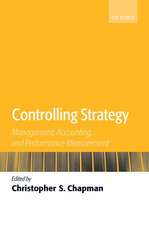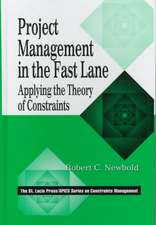Corporate Social Capital and Liability
Editat de Roger Th.A.J. Leenders, Shaul M. Gabbayen Limba Engleză Hardback – 30 iul 1999
| Toate formatele și edițiile | Preț | Express |
|---|---|---|
| Paperback (1) | 1230.03 lei 43-57 zile | |
| Springer Us – 31 oct 2012 | 1230.03 lei 43-57 zile | |
| Hardback (1) | 1236.51 lei 43-57 zile | |
| Springer Us – 30 iul 1999 | 1236.51 lei 43-57 zile |
Preț: 1236.51 lei
Preț vechi: 1507.94 lei
-18% Nou
Puncte Express: 1855
Preț estimativ în valută:
236.68€ • 257.17$ • 198.94£
236.68€ • 257.17$ • 198.94£
Carte tipărită la comandă
Livrare economică 21 aprilie-05 mai
Preluare comenzi: 021 569.72.76
Specificații
ISBN-13: 9780792385011
ISBN-10: 0792385012
Pagini: 580
Ilustrații: VII, 562 p.
Dimensiuni: 155 x 235 x 36 mm
Greutate: 0.98 kg
Ediția:1999
Editura: Springer Us
Colecția Springer
Locul publicării:New York, NY, United States
ISBN-10: 0792385012
Pagini: 580
Ilustrații: VII, 562 p.
Dimensiuni: 155 x 235 x 36 mm
Greutate: 0.98 kg
Ediția:1999
Editura: Springer Us
Colecția Springer
Locul publicării:New York, NY, United States
Public țintă
ResearchDescriere
In studies of inter-organizational relations (lOR's), there is a tendency to look at dyads of flrms, and to consider networks as aggregates of such dyads. But there are several roles for a third party; a go-between. This chapter looks at a go-between not in the sense of a middleman who intermediates in existing production or trade, such as an agent, wholesaler, retailer, and not in the sense of an entrepreneur who intermediates in the realization of new potential in connecting supply and demand. It looks at a go between in the sense of a relationship counsellor for the development and maintenance of social capital; providing support in setting up, adapting and ending cooperative relations between others. Or, in yet different terms: to help in the embedding of relati ons, in Granovetter's (1985) sense (Uzzi 1997a). Such roles may be performed by middlemen or entrepreneurs, but also by specialized agents who do not playa direct role in linking stages in a chain of production and distribution, as middlemen and entrepreneurs typically do. Indeed, some of the roles require an independence that is served by not having a direct stake in the relations that need to be developed. I propose that the analysis yields a perspective for looking at the roles of trade and industry associations in European business systems, and of banks and trading houses in Japanese enterprise groups (Kigyo Shudan).
Cuprins
Introduction: CSC: The Structure of Advantage and Disadvantage; S.M. Gabbay, R.Th.A.J. Leenders. Section I: Conceptual Issues - Theory, Models, and Measurement. 1. Organizational Networks and Corporate Social Capital; D. Knoke. 2. Social Capital of Organization: Conceptualization, Level of Analysis, and Performance Implications; J.M. Pennings, K. Lee. 3. A Relational Resource Perspective on Social Capital; L. Araujo, G. Easton. 4. Social Capital by Design: Structures, Strategies, and Institutional Context; W.E. Baker, D. Obstfeld. 5. Corporate Social Capital and Liability: a Conditional Approach to Three Consequences of Corporate Social Structure; I. Talmud. 6. Dimensions of Corporate Social Capital: Toward Models and Measures; S.-K. Han, R.L. Breiger. 7. Organizational Standing as Corporate Social Capital; P. Doreian. 8. Customer Service Dyads: Diagnosing Emperical Buyer - Seller Interactions along Gaming Profiles in a Dyadic Parametric Space; D. Iacobucci. Section II: Structure at the Individual Level - Social Capital in Jobs and Careers. 9. The Sidekick Effect: Mentoring Relationships and the Development of Social Capital; M. Higgins, N. Nohria. 10. Social Capital in Internal Staffing Practices; P.V. Marsden, E.H. Gorman. 11. Getting a Job as a Manager; H. Flap, E. Boxman. 12. The Changing Value of Social Capital in an Expanding Social System: Lawyers in the Chicago Bar, 1975 and 1995; R.L. Sandefur, et al. Section III: Structure at the Individual Level &endash; Social Capital and Management. 13. Generalized Exchange and Economic Performance: Social Embeddedness of Labor Contracts in a Corporate Law Partnership; E. Lazega. 14. CEO Demographics and Acquisitions: Network Effects of Educational and Functional Background; P.R. Haunschild, et al. 15. Public Service Organizations &endash; Social Networks and Social Capital; E. Ferlie. 16. The Dark Side of Social Capital; M. Gargiulo, M. Benassi. 17. Social Capital, Social Liabilities, and Social Resources Management; D.J. Brass, G. Labianca. Section IV: Structure at the Firm Level &endash; Social Capital in Collaboration and Alliances. 18. The Triangle: Roles of the Go-Between; B. Nooteboom. 19. The Management of Social Capital in R&D Collaboration; O. Omta, W. van Rossum. 20. Technological Prestige and the Accumulation of Alliance Capital; T.E. Stuart. 21. Networks and Knowledge Production: Collaboration and Patenting in Biotechnology; L. Smith-Doerr, et al. 22. Supply Network Strategy and Social Capital; C. Harland. Section V: Structure at the Firm Level &endash; Social Capital and Financial Capital. 23. Choosing Ties from the Inside of a Prism: Egocentric Uncertainty and Status in Venture Capital Markets; J.M. Podolny, F. Castellucci. 24. Corporate Social Capital and the Cost of Financial Capital: An Embeddedness Approach; B. Uzzi, J.J. Gillespie. 25. Venture Capital as an Economy of Time; J. Freeman. Conclusion. References. Index. Contributors. Editors.

















